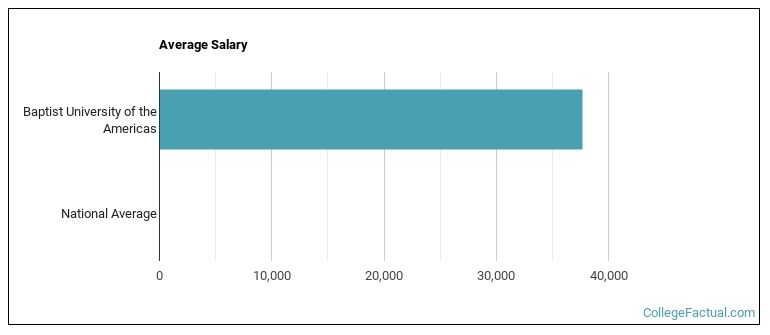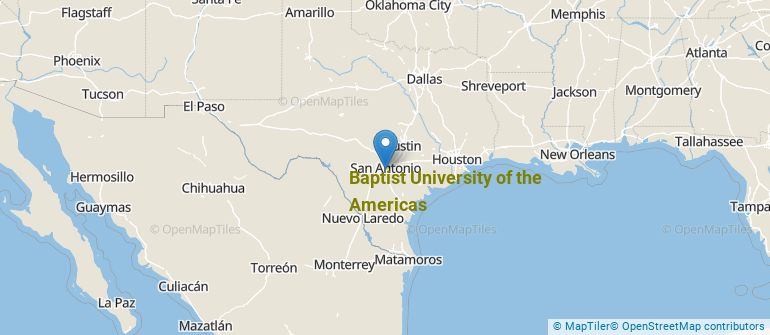 by our College Data Analytics Team
by our College Data Analytics TeamExplore the best ranked schools for the programs you are most interested in.
Baptist University of the Americas was not ranked in College Factual's 2025 Best Overall Colleges report. This could be for a number of reasons, including lack of data.
See all of the rankings for Baptist University of the Americas.
Baptist University of the Americas has an open admissions policy, so you should not have much trouble being accepted by the school. Still, it is important to fill out the application completely and submit any requested materials, which may include proof that you have a high school diploma or the equivalent.
The student to faculty ratio is often used to measure the number of teaching resources that a college or university offers its students. The national average for this metric is 15 to 1, but at Baptist University of the Americas it is much better at 10 to 1. That's good news for students who want to interact more on a personal level with their teachers.
The freshmen retention rate tells us what percentage of first-year, full-time students choose to continue on to their sophomore year at a particular school. The rate at Baptist University of the Americas is 63%, which is about average when compared to the national rate of 68%.
When we say that a student has graduated on time, we mean that they have finished their bachelor's degree within four years. The on-time graduation rate at Baptist University of the Americas is 6%. That's lower than the national rate of 33.3%
Find out more about the retention and graduation rates at Baptist University of the Americas.
During the 2017-2018 academic year, there were 117 undergraduates at Baptist University of the Americas with 78 being full-time and 39 being part-time.
The net price is calculated by adding tuition, room, board and other costs and subtracting financial aid.Note that the net price is typically less than the published for a school. For more information on the sticker price of Baptist University of the Americas, see our tuition and fees and room and board pages.
Almost 66% of college students who graduated with the class of 2018 took out student loans, but that percentage varies from school to school. At Baptist University of the Americas, approximately 13% of students took out student loans averaging $990 a year. That adds up to $3,960 over four years for those students.
The student loan default rate at Baptist University of the Americas is 1.0%. This is significantly lower than the national default rate of 10.1%, which is a good sign that you'll be able to pay back your student loans.
Get more details about paying for Baptist University of the Americas.

See which majors at Baptist University of the Americas make the most money.
Get more details about the location of Baptist University of the Americas.

Contact details for Baptist University of the Americas are given below.
| Contact Details | |
|---|---|
| Address: | 2418 W. Ansley Blvd., San Antonio, TX 78224-1443 |
| Phone: | 210-924-4338 |
| Website: | www.bua.edu/ |
| Most Popular Majors | Bachelor’s Degrees | Average Salary of Graduates |
|---|---|---|
| Business Administration & Management | 9 | NA |
| Liberal Arts General Studies | 9 | NA |
| Theological & Ministerial Studies | 7 | NA |
| Romance Languages | 0 | NA |
| Multicultural & Diversity Studies | 0 | NA |
| Biblical Studies | 0 | NA |
| Religious Education | 0 | NA |
| Music | 0 | NA |
Online learning options are becoming more and more popular at American colleges and universities. Online classes are great for students who have busy schedules or for those who just want to study on their own time.
In 2022-2023, 109 students took at least one online class at Baptist University of the Americas. This is a decrease from the 129 students who took online classes the previous year.
| Year | Took at Least One Online Class | Took All Classes Online |
|---|---|---|
| 2022-2023 | 109 | 49 |
| 2021-2022 | 129 | 67 |
| 2020-2021 | 116 | 85 |
| 2018-2019 | 44 | 6 |
Learn more about online learning at Baptist University of the Americas.
Footnotes
*The racial-ethnic minorities count is calculated by taking the total number of students and subtracting white students, international students, and students whose race/ethnicity was unknown. This number is then divided by the total number of students at the school to obtain the racial-ethnic minorities percentage.
References
More about our data sources and methodologies.